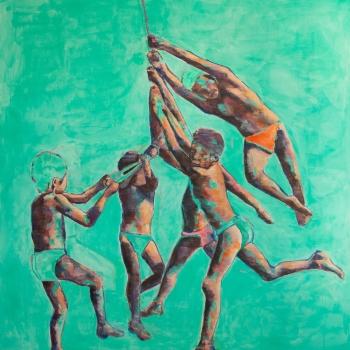The Slow Show
Biographie The Slow Show
The Slow Show
'Progress is slow', Fred 't Kindt says. And of course he's right. Listening to 'Still Life' for the first time, you’d think it's The Slow Show as you know it. Returning to debut 'White Water', only six years old, you realise this has become a different band. 'It's in the name', the keyboard player grins. 'You think we don't evolve, but as you can hear on this record we've stepped quite a bit out of our comfort zone.'
This is the fourth album by The Slow Show, and it has been a ride. Between the start of the band around 2012 and the Moment the World Stood Still, this band had an amazing eight years. From their breakthrough 'White Water' on, it was clear The Slow Show was not 'just another band from Manchester.' The legacy of The Smiths, Joy Division and all those other great predecessors is not something to be trifled with, but The Slow Show didn't need to wear their address on their sleeve: this was something else, fully formed, with a mesmerising sound, rich in atmosphere and melody, with hints of The National. Americana with a stiff upper lip, you might want to call it.
Today, The Slow Show isn't even a Manchester band anymore. How could it be, with guitarist Joel Byrne-McCullough born and bred in Northern Ireland, 't Kindt originating from Belgium. Since 2019, singer Rob Goodwin even lives in Germany, where the band always found a lot of welcoming arms. It was the Haldern Pop-label that gave the band its first opportunities, releasing 'White Water' in 2015 to great acclaim. The press loved the intricate melodies, sweeping songs like 'God Only Knows' and 'Brother'. When 'Dream Darling' followed, only a year later, the band had already reached a next step: playing bigger crowds all over Europe.
On third album 'Lust And Learn', The Slow Show took a left turn. There, the unusual mix of influences came into focus. Of course, you still hear Goodwin’s knack for classic song writing, but also 't Kindt’s classical education, in pieces like 'Amend' or 'Breath:Air', or Byrne-McCullough’s jazz-upbringing. And on 'Brother', you already might have picked up on drummer Chris Hough’s background in brass bands. 'Lust And Learn' was rich in detail, replacing big gestures with small, beautiful movements.
And now this. 'Still Life'. Same but different again. 'We did develop our sound', says Goodwin. 'We had to try something else. We felt we owed that to ourselves, and to the people that come and enjoy the music. We explored a lot of stuff: different sounds, different feelings, different ideas, different processes as well. Some of them didn't work at all, but some did. It was difficult and challenging, but it felt good in the end.' And then you hear it, indeed. This is no longer the alt-rock band of 'White Water' and 'Dream Darling'. Those albums had big songs, with hooks and choruses. And where 'Still Life' keeps the subtle tapestries of third album 'Lust And Learn', it also lurches forward, searching for new territories.
'I actually see what we make now as instrumental music.' Maybe it's guitarist Joel Byrne-McCullough’s take that delivers the clearest explanation of the evolution on the last two Slow Show albums. 'Of course there's Rob’s vocals, but they are adding to the mix as an instrument. We've moved away from the more traditional song structures.'
A lot more is new on this album. 'Some new approaches and sounds crept in', 't Kindt says. 'Some were far from our older work. For instance: after some initial encouragement from me, Rob was keen to sing a bit higher on this record. Chris was encouraged to make his drums a bit more present; some things almost sound like a breakbeat to my ears.'
'I've really enjoyed the last tours, where we started to see some movement in the audience', says Goodwin about that. 'Fred and I often talk about these 'head nod moments', because nothing makes me happier than seeing a bunch of heads nodding to our music. That was a real thought I had when we were writing some of those rhythms. I really hope that people just shut their eyes and nod their heads to this, you know, but maybe slightly quicker than in the past.'
So why 'Still Life'? 'I love the art form', Goodwin deadpans, 'the still lives painters make. But at the same time, of course, I was in a sort of stationary position. Before the virus arrived, I had a busy life; spending two weeks in Germany with my girlfriend, and then flying to Manchester to work with Fred or to a gig. And then all of a sudden, life came to a halt. It took a little getting used to, but I actually had a really nice realisation during that time. I understood that the slower life got, the more I saw. I spent a lot of time in nature, seeing things in a different perspective. And that's what you need, when you're trying to create. You have to really look, and then you see things happening everywhere.'










